“Flights and domestic travel plans for our Japan holiday? Check! List of foods and restaurants we want to try? Check, check! The perfect hotel for our holiday needs? Check, check, check! … But wait! I wanted to experience a traditional Japanese ryokan while we are there, too!”
I hear this all the time from those in the ‘sorting out accommodation’ stage of their Japan trip. Most people also admit they don’t know where to begin when booking a Japanese ryokan.
Many prospective travellers also tell me that they don’t know what exactly a ryokan is.
Time and budget allowing, a ryokan is a beautiful addition to any Japanese vacation. I honestly believe that it is also a way to understand more about Japan and Japanese culture.
I started my time in Japan as an exchange student. Staying at a ryokan was out of my reach until I became an adult. So when I did, I was surprised at how much it took me back to my Japanese homestay experience.
Suddenly, I was full of nostalgia. Nostalgia for the smell of tatami and those sliding paper doors. Nostalgia also for that feeling of curling up on a futon under a fluffy kakebuton (a Japanese-style futon duvet .)
To me, a ryokan feels like a Japanese version of home – a home in a parallel universe where everyone waits on me hand and foot and spoils me rotten, that is.

What are Ryokans?
A ryokan is translated as ‘a traditional Japanese inn.’ While not incorrect, these words don’t adequately explain the ryokan experience.
A ryokan is hard to describe without a frame of reference. There is little to compare it to – particularly for international travellers. If I were to describe a ryokan to a friend who had never travelled to Japan, I would say most ryokan offer luxury accommodation.
However, not all ryokan are at the ‘luxe’ end of the market. You can also find more homely, family-run ryokan (closer to a traditional Japanese inn).

Unlike a hotel, at a Japanese ryokan, the guest experience is intimate and intrinsically tied to Japanese culture’s deep respect for and pride in ‘omotenashi’ hospitality.
Ryokans are designed to be enjoyed from check-in to check-out time. This experience includes multi-course meals (often served in the guest’s room) and use of the hotel’s onsen facilities.
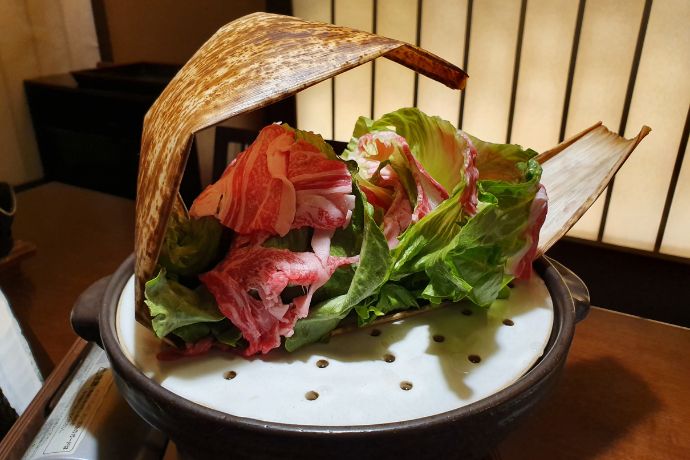
At a ryokan, the room is almost always entirely tatami-flooring. The furniture is minimal, and the staff will set up your futons in the evening and pack them away in the morning.
A Brief History of Ryokans
Ryokans became popular with traders and samurai in the 17th century on the route between Tokyo and Kyoto. More ryokans arose as trade increased between the two cities. It is said that the first ryokan was in Yamanashi prefecture in a hot-spring area called Hayakawa.
Nowadays, a Japanese ryokan is used in a similar way that some people in Western countries may stay at a spa for a treat. The idea is to be pampered and to decompress without the distractions of house chores or work commitments.
When staying at a ryokan, Japanese guests travel to country towns to be one with nature. Visitors to ryokans get some time outside of the city and indulge in high-quality local produce of the season, all while being pampered for the entire stay.
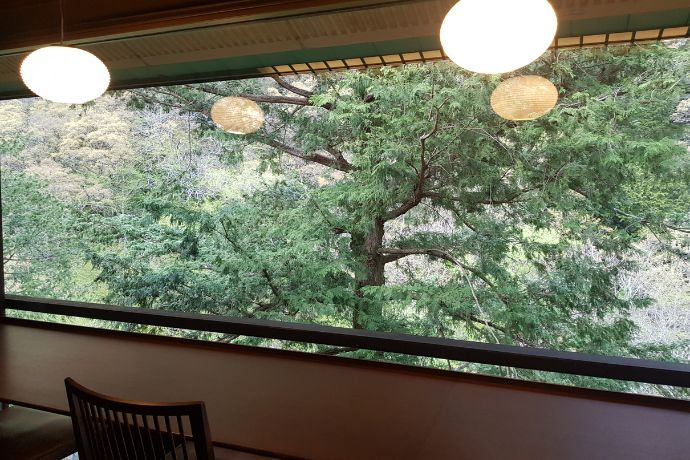
Ryokans are also often used as a way for Japanese extended families to spend time together. You may already be aware, but Japanese homes are small. For this reason, having grandma or a sibling’s family come over to stay is rarely an option in Japan. So, a ryokan stay is a way for Japanese families to bond over food and have the space to spend quality time together.
These days, there are different variations of a ryokan available throughout Japan, such as more modern furnishings, western-style dining options, restaurants within the building or room-only options (without dinner and breakfast included). However, if you ask most Japanese people to recommend a ryokan, their mind will automatically go to a traditional Japanese ryokan in a country town in a hot spring region.
How are Ryokans Different from Hotels?
Ryokans offer a unique lodging experience distinct from standard hotels. Here’s what sets them apart in the realm of Japanese accommodation.
1. It’s not just a place to lay your head
A hotel is a place to lay your head while travelling, while a ryokan is an experience. It is unusual for ryokan guests to venture far from their ryokan during their stay as the time at the ryokan is the holiday.
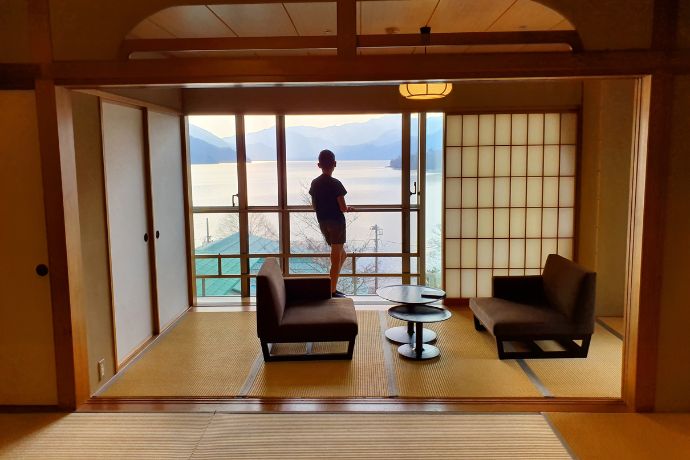
2. Meals are (almost always) included in the stay
Meals will be served in private dining rooms, in the guest’s room or a larger common dining area. Most commonly, guests are in a kneeling or cross-legged position while they dine.

3. Amenities are all included, including room wear/sleepwear
Ryokans supply yukata or a Japanese version of pyjama-style ‘room wear.’ These are designed to be worn while using the ryokan facilities. Toiletries are also provided.
Theoretically, a guest could turn up empty-handed and still have a beautiful, relaxing stay.
4. The service and attention to detail is second to none
If you’ve read up on Japanese culture, you may have encountered the term ‘omotenashi’. It means the host anticipates the guest’s needs to make their stay or meal run smoothly and be as enjoyable as possible.
Although it can feel like you are staying in a wealthy Japanese person’s home, the service style in Japanese ryokans is still professional, and the boundaries between the server and guest are very clear. I mention this as I don’t want anyone to mistake a ryokan for a homestay or farm-stay experience.
I’ve never met someone who wasn’t blown away by the high level of customer service at a ryokan in Japan. In Australia (where I’m from), there is that saying that ‘the customer is always right.’ Well, Japan takes this to the next level (of course). The Japanese saying is ‘okyakusama wa kamisama’ (the customer is god.)
5. Ryokan staff enter the guest room often
This can take some adjusting to if guests are used to a hotel where the staff are only to enter the room after being called to do so. However, while staying at a ryokan, the staff are like little ‘hospitality fairies’ who flitter in quickly to clear up, reset the room, deliver tea, etc.
The Main Parts of a Ryokan Experience
Staying at a ryokan offers a unique glimpse into traditional Japanese customs and practices. Here’s a detailed breakdown of what to expect during your ryokan experience.
Check-in Process
Guests are expected to arrive at the check-in time. You should notify the hotel if you will be running late. It’s good to arrive one to two hours before dinner (generally at 6 or 7 pm) to allow time to settle in and relax, and perhaps even enjoy an onsen experience.
The process of checking into a ryokan in Japan involves check-in paperwork and then collecting any luggage that has been forwarded ahead of time. Check-in may occur in the lobby lounge area, at the reception desk or sometimes in your room. Tea and snacks are commonly offered during check-in.
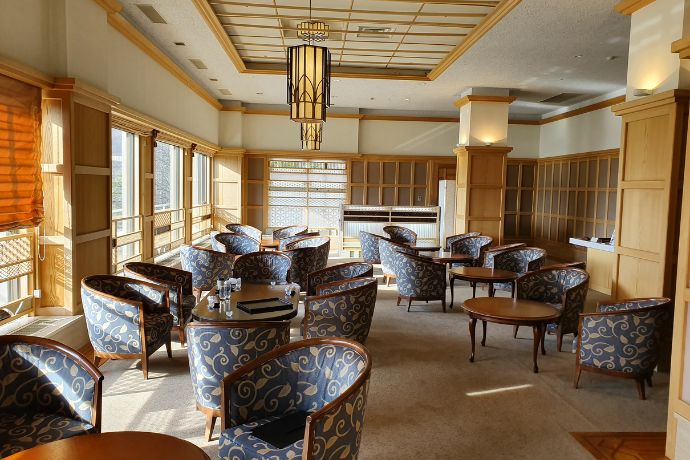
Staff then show you to your room and give instructions on using the in-room functions such as temperature control, etc.
In smaller ryokan (in particular), you commonly need to remove your shoes at the entrance. Typically, shoes need to be pointed towards the door. In some ryokan (particularly larger ones), you remove your shoes in the entry area of your room.
Onsen
For many Japanese families, the main event is almost always the onsen segment of a ryokan stay. Trust me, as someone who lived with many Japanese families in my high school years, the grandma of the home was always happy to loudly rate onsens in certain ryokans, which could not possibly compare to others.
Onsen are generally shared facilities. However, some ryokan offer private onsen. These usually need to be reserved in advance. Some higher-end ryokan have hot spring baths in rooms.
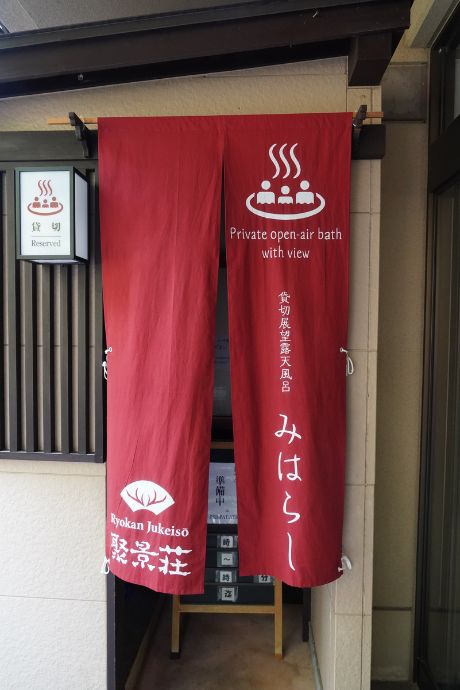
When visiting the onsen from a guest room at a ryokan, the ‘done thing’ is to wear the provided yukata or pyjama-style style room wear. The idea is to wear nothing underneath this garment – no underwear.
For those who don’t feel comfortable being naked under a yukata, underwear is fine, but there will be more layers to peel off in the onsen change rooms.
There is no need to take any other items as all cleaners, moisturisers, razors, hair ties and towels are provided within the onsen change rooms.
The onsen is almost always separated by gender, so one side is for male guests and the other for female guests. Gender can be worked out by the curtains at the entrances to the changing room door. The curtains are usually blue for men and red for women.

The two baths/onsen facilities are not identical, and sometimes they can also have different minerals or health benefits. For this reason, the male side and female side switch the following morning. That way, guests can all have the opportunity to experience both sides.
Before anyone asks – yes, you do need to be completely naked and yes, you need to thoroughly wash your body at the body washing/showering area before hopping in the hot bath.
Basic Process for Using the Onsen
Remove clothing in the changing room and place it in the provided locker. There will be both small and larger towels, each with a particular purpose.
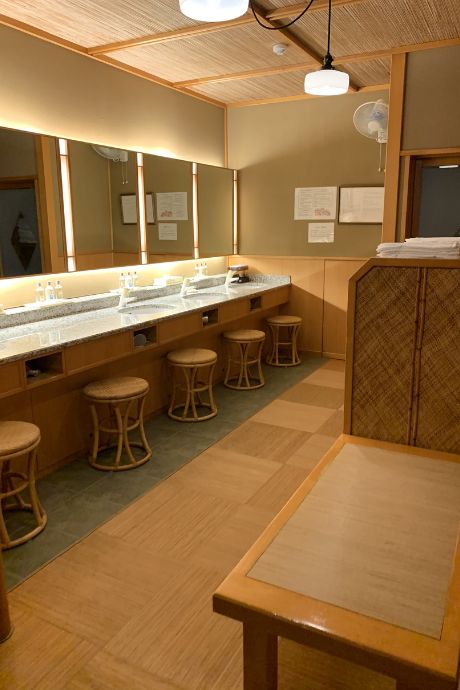
Use the washing and shower section to complete all the soap, shampoo and shaving parts of cleaning the body.
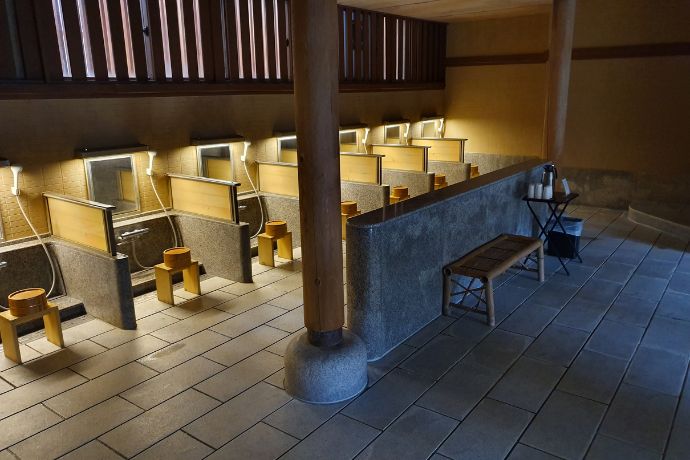
Take a small body towel for modesty. It’s very small, about the size of a hand towel, but I still take it every time. The small towel isn’t meant to enter the water, so it needs to go on the side of the bath or be folded on top of your head.
Hop into the bath and soak for as long as you like, and feel free to sit on the edge when the water feels too hot before reentering the bath. Keep talking and splashing to a minimum to make it as relaxing as possible for all guests.

Hop out of the bath and use the small towel for a quick dry so you don’t get the floor wet, then return to the change room area to grab the larger towel so you can dry completely.
Change back into your hotel-provided room wear. Use the dressing table/salon seating area in the change room, including the provided hairdryers and skincare.
Kotatsu
In Winter, you may be fortunate to have a kotatsu in your room at your ryokan in Japan.
A kotatsu is a low four-legged table with a blanket draping to the floor. It looks like a coffee table turned cubby house. Under the table is an electric heater. It’s like an amazing, cozy little heat cave. It’s a lovely way to warm up.
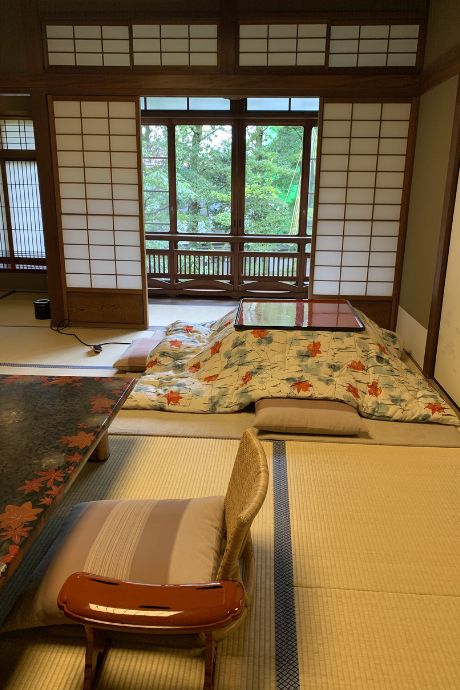
When I lived with a Japanese host family in high school, the family’s pet cat would sleep under the kotatsu all day. As someone who dislikes cold weather – I can relate.
Yukata & Geta
Yukata (a very light kimono-style gown) is provided in ryokans for all guests. It means that everyone can move freely around all areas of the ryokan.
When putting on yukata, fold the right-hand side over the left-hand side. While holding the yukata in place, wrap the obi belt around your waist and tie it in front. The knot should lie over the right hip. For men, the obi should rest low on the hips and for women, it should be tied at the waist.
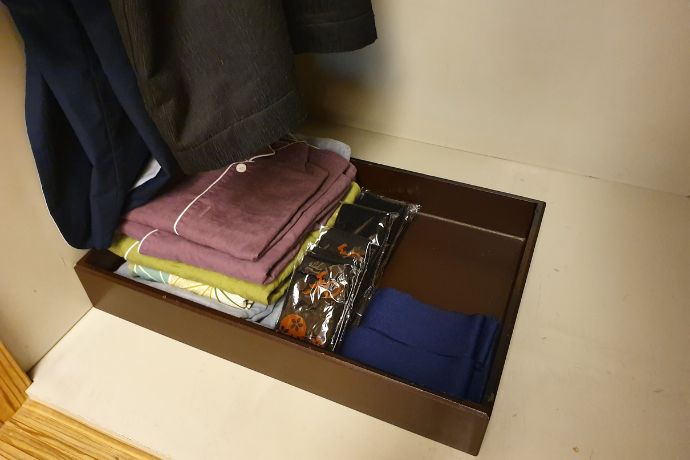
It is common for Japanese people to be unsure which part of the ryokan they can enter while dressed in a yukata. So, it’s okay to ask questions. Some areas of a ryokan might have a restaurant where they prefer guests not to wear their yukata, for example.
Geta are slippers used for getting between outdoor areas. Geta are like slippers, but the base is made of wood – so you could liken them to Japan’s version of clogs.
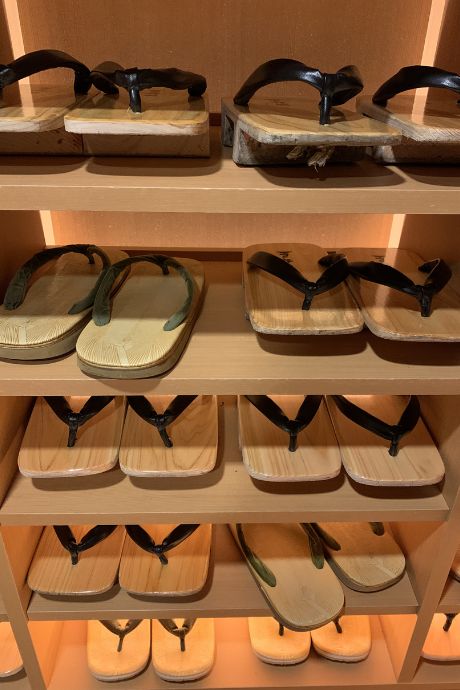
Futons
In a ryokan, even if guests spot their futon and other bedding inside the cupboard in their room, it is the job of the staff at the ryokan to set up the bedding at sleep time and then pack it away again in the morning.
Guests are also always welcome to ask for additional blankets.
Contrary to the predictions of many, sleeping on a futon is extremely comfortable and cozy. Especially after taking a hot bath in an onsen.
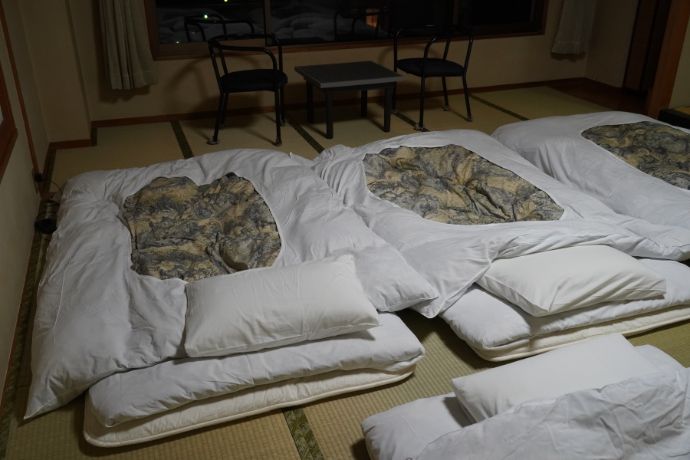
Kaiseki Dinner
Dinner and breakfast are usually included in the cost of staying at a ryokan.
Dinner is one of the main events of the stay, and it is, traditionally, kaiseki-style dining. Dinner may be offered in a private dining room, or a communal dining area, and some even serve dinner in your room. Most people wear their yukata to dinner, but often, regular clothes are also acceptable.
Kaiseki means lots of little courses served on little dishes. The courses include appetisers, miso soup, boiled dishes, grilled dishes, deep-fried dishes, rice, pickles and a dessert.
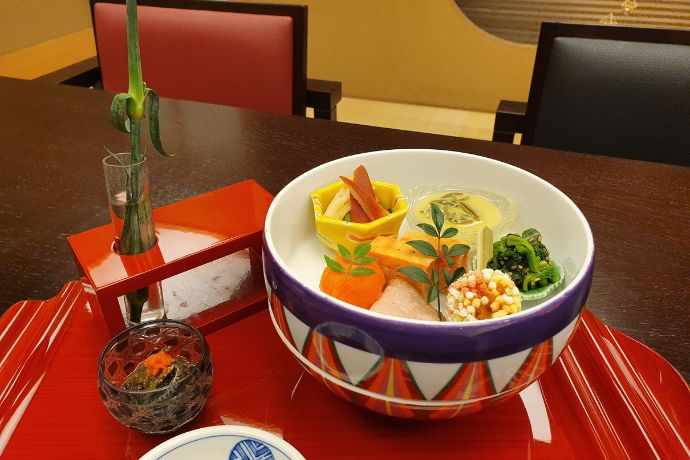
The crockery is also usually handmade by local pottery artists. The order of the meal is carefully planned.

The menu consists of local ingredients to reflect the area and the season. For example, in Autumn, you are more likely to be served chestnuts, grilled sanma (an autumn swordfish), Japanese pumpkin or matsutake mushrooms chestnuts (to name a few.) While in Winter, for example, you will be more likely to be served daikon radish, renkon (lotus root), crab or grilled meats.

Many first-timers to ryokans worry about not finishing all of their meal. I’m here to assure ryokan guests not to worry so much. While it would make the staff extremely happy to see their guests enjoying every morsel of their kaiseki feast, the guests are the customers, so they can, of course, choose whatever they would like to consume.
My approach if something isn’t to my taste after trying it, I thank the staff as they clear the dishes and mention another item I really enjoyed instead. This is a gentle and kind way to explain that it’s not really the kind of thing that I enjoy. Japanese is a very polite and not a blunt language, so this is probably the closest English equivalent.
Here are some language tips when eating:
- Tabetemimashita. Arigatou gozaimashishita. (I tried it. Thank you so much.)
- Mezurashi aji desu. (The taste is new and different *for me*)
- Kore wa oishii desu (This is delicious)
- Tabekirenakutte sumimasen (I’m sorry I couldn’t finish it.)
- Kore wa nandesu ka? (What is this, please?)
- Tabekata oshiete kudasai (Could you please show me how to eat this?)
Ryokan Breakfast
At a traditional ryokan in the countryside, the breakfast options may only be traditional Japanese breakfast options. That may mean some rice, miso soup, seasonal fish, some pickles and some fresh fruit. Some ryokan offer a western-style breakfast.
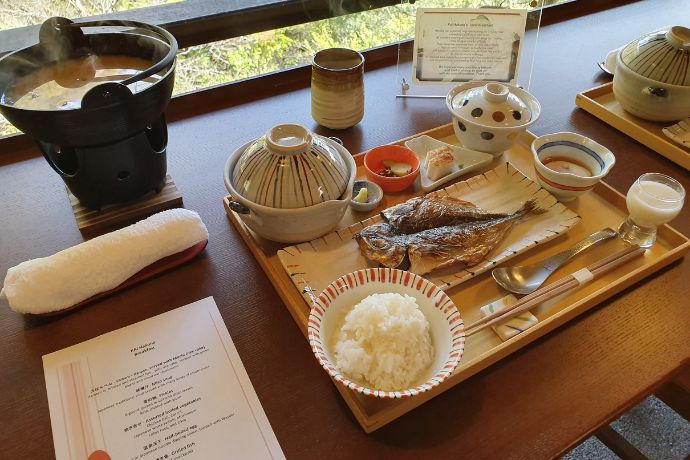
Some ryokan serve breakfast at your table, while others offer buffet-style breakfasts.
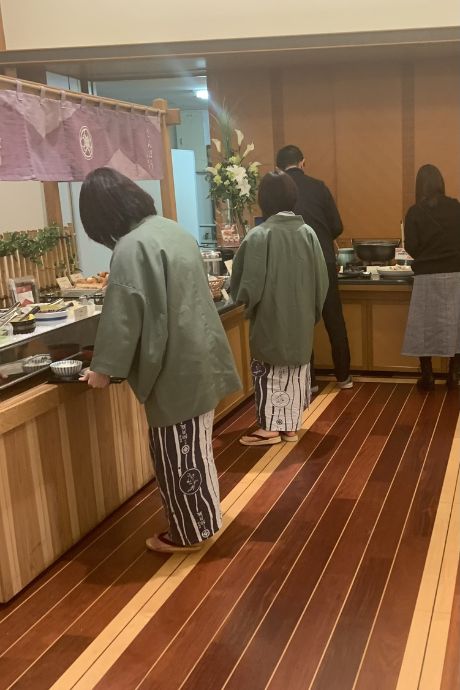
As mentioned above, ryokan guests can eat what they would like and leave what they would like. It is polite to try everything at their table setting, but it is by no means obligatory.
Omiyage Shops
Some ryokan will have omiyage (souvenir) shops near the check-in area. These options are almost always handicrafts of the area, the robes/yukata or the skincare from the ryokan to take home.
Guests may also be fortunate enough to be able to buy local fabrics, pottery and dried fruits or cakes to take home.
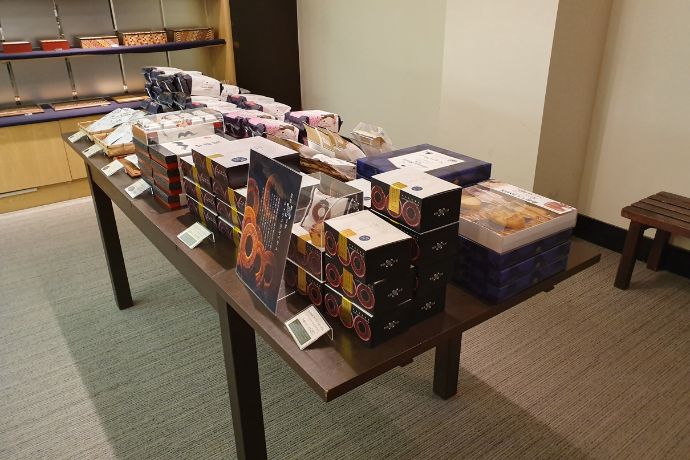
How to make the most of a stay at a Ryokan in Japan?
My advice on how to make the most of a ryokan stay (and how to be a good guest at a ryokan) is to:
Keep an open mind about the whole experience
The bedding, the food, and the bath time may differ from what guests are used to back in their home country.
Ryokan guests who have the best time and the most complete experience embrace it wholeheartedly. It’s a short stay, and the time goes quickly. A stay in a ryokan is one of the best ways to deep-dive into Japanese culture. A ryokan stay is a priceless experience.
Don’t question the order or the well-orchestrated process of a Japanese ryokan.
The order and process are an important part of Japanese culture, and every step of meals, as well as bathing and sleeping rituals, have been intentionally crafted to give the guest a truly calm and balanced experience.
It is not designed to be customised – especially meal times and room layout. From an international guest’s point of view, this can sometimes be inflexible, but this is actually about allowing the slower pace and the carefully designed historical rituals of an onsen to be a part of a ryokan stay. As I said at the beginning of this article, – a ryokan is not simply a place to lay one’s head.
Remain self-aware when it comes to the cultural norms within the ryokan
“Is everyone else speaking quietly in this room? Perhaps I should, too.” “Is no one else wearing their yukata in this section right now? Maybe I need to go back and change.”
Arrive at check-in time.
If held up, it is expected that guests will let the ryokan front desk know ahead of time.
Ask questions when unsure.
I’ve never met a Japanese person who didn’t find questions about ‘house rules’ or Japanese culture or food etiquette to be endearing.
Questions show that guests are trying. Questions show curiosity and the willingness to learn more. That’s very beautiful if you ask me.
Where to Find Ryokans
Ryokan can be found all across Japan. The most popular places to stay in a ryokan in Japan are, of course, the onsen towns. Some of these are Hakone, Beppu, Kinosaki, Ginzan, and Nozawa. However, they can also be found in cities.
For guests who love trying several onsens, Kinosaki Onsen is a stand-out option as guests can try onsens throughout the whole town during their stay. Shibu Onsen near the Japanese Snow Monkey Park is also terrific if you want to try different onsen in the town.
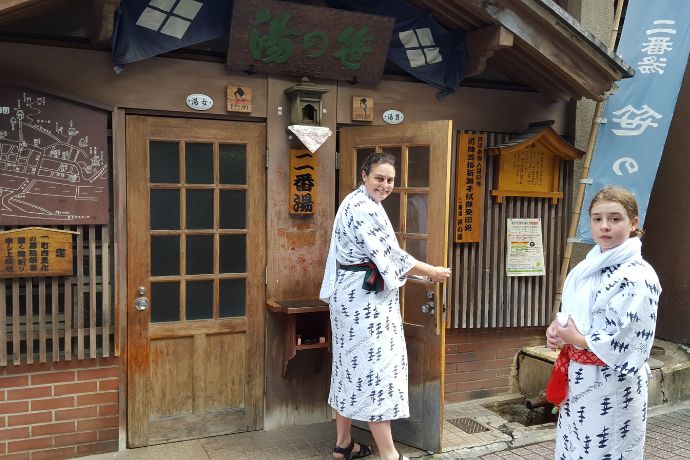
Many ryokans are listed on hotel booking sites such as Booking.com. If you select a location, on the left hand side of the screen, you can filter to see the ryokan options. Ryokans can also be booked directly via their websites or through a Japan-based travel agent or specialised Japanese travel agent.
Same-day reservations are generally not possible due to being already booked out. The other reason a same-day booking is not viable is that the meals are complicated and intricate and need to be prepared in advance before you arrive.
As locations can be remote, it is a good idea to see if the ryokan offers shuttle buses from train stations before making a reservation.
Things to Consider When Booking a Ryokan
When making a reservation at a ryokan, it’s good to know that the cost is usually per person, not per room.
Ryokans are placed into budget categories in Japan. Category D is the most casual of the ryokan types, and prices can start at 7000 yen per adult per night. The highest end of ryokans is Category +++, and prices can be more like 70,000 yen per adult per night.
It is important to check ahead before booking if the ryokan allows for guests with tattoos. Many won’t allow for tattoos that are covered, either. So it is best to check. https://tattoofriendlyjp.com/ is a great resource when researching ahead.
Guests can not assume that any ryokan can accommodate special dietary requirements. I recommend emailing to find out before making a reservation. It is also good to give a ryokan at least two weeks’ notice for special dietary requirements (after checking first that this is even an option.)
What are Ryokan Rooms Like?
Ryokan rooms can vary a lot, but they generally share some standard features. They usually accommodate 2-4 people, have tatami floors, and a sitting room. Make sure you don’t dirty or damage the tatami with your footwear or luggage.
In most ryokan, you sleep on a futon. Most traditional ryokan will have a large window for guests to take in the area’s greenery while in their room.
Ryokan rooms have minimal furniture. The furniture is low and is often placed on the edges of the room.
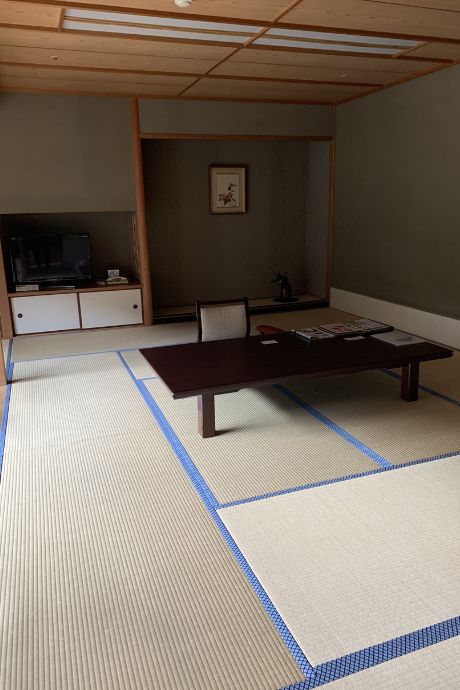
The room is to be a relaxing open space by day and transforms into a sleeping place by night.
Amenities include fridges and bathrooms with toothbrushes and bathroom products. Yukata and geta (or other footwear) are provided. Some ryokan have shared toilets and bathrooms.
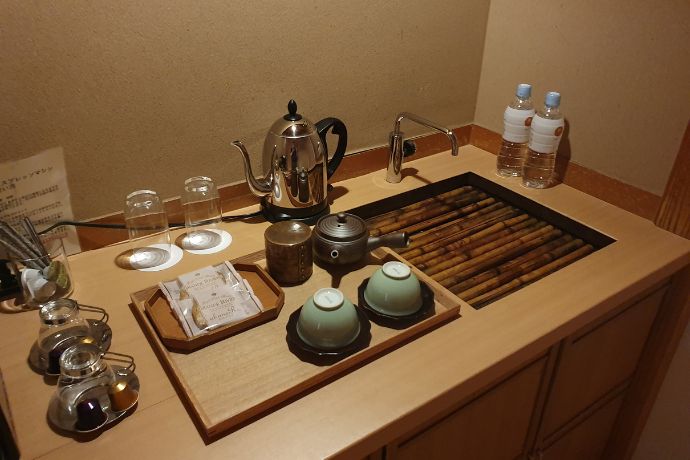
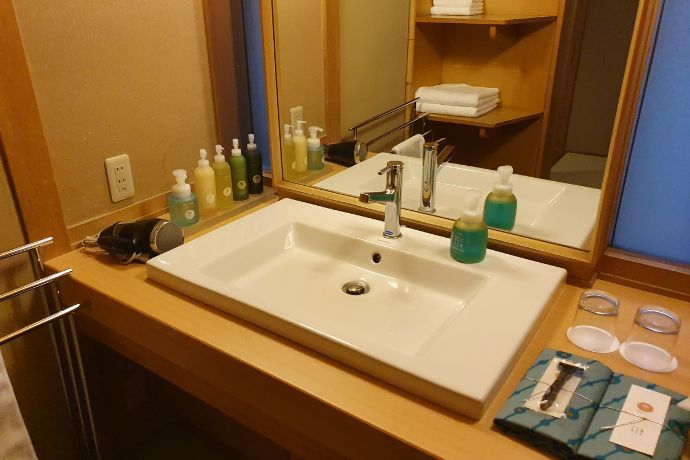
You might find that different slippers are provided for bathrooms/restrooms, so as not to use the some footwear in common areas.
There are also modern versions of a ryokan, such as Imagine Hotel Japan in Kyoto, which may have different styles of flooring or bedding but still retain a minimalist Japanese aesthetic.
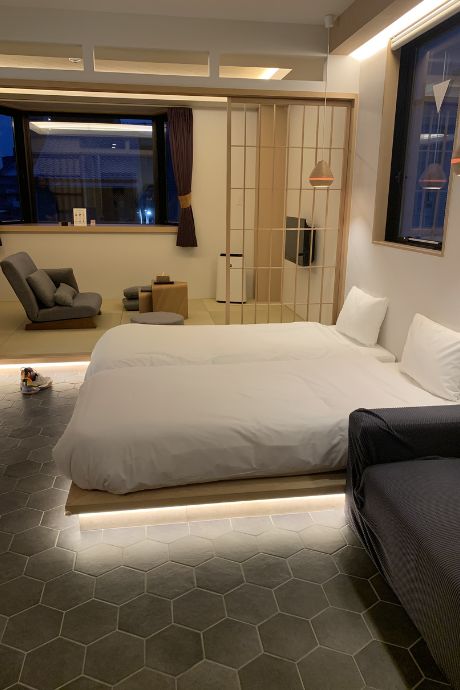
How can Different Types of Ryokan Vary?
In inner city areas, more modern ryokans can nowadays have a separate restaurant within the ryokan facilities.
Others contain televisions in the rooms, and even more casual ryokans don’t include the food in the accommodation pricing at all (although Japanese people would argue that this, then, is not a ryokan at all.

Some ryokans also offer Western-style beds instead of futons.
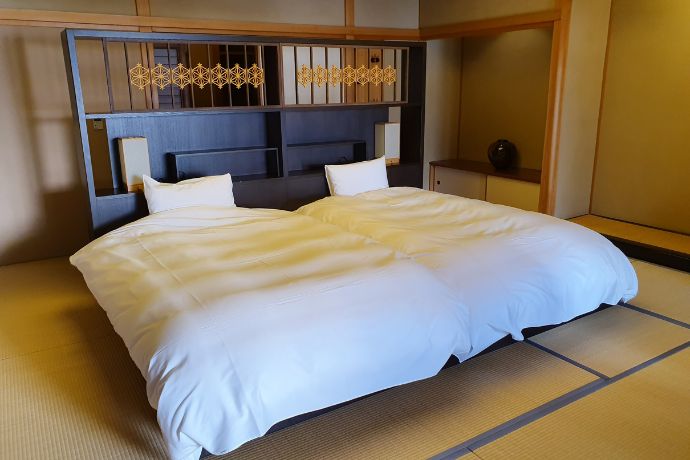
Some high-end ryokans offer timed entry to a private bath or a suite-style room with a private onsen bath on the balcony, although these are not easy to find and are considerably more expensive.
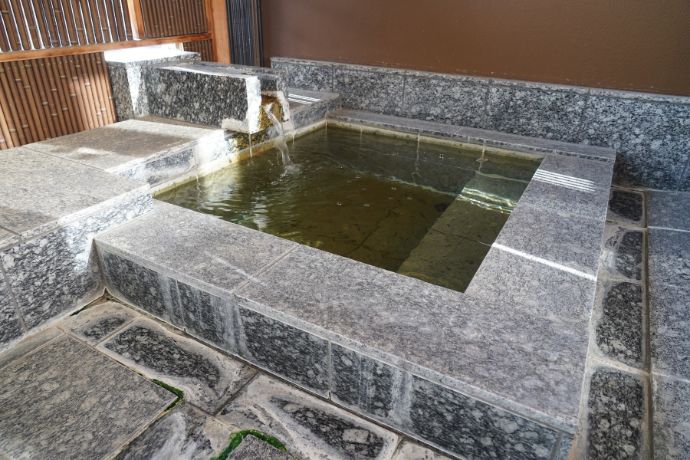
Things to do at Ryokans
The done thing to do at a ryokan is … well … nothing much at all. Enjoy bathing, eating and sleeping.
You might be able to wander on the grounds and gardens of the ryokan.
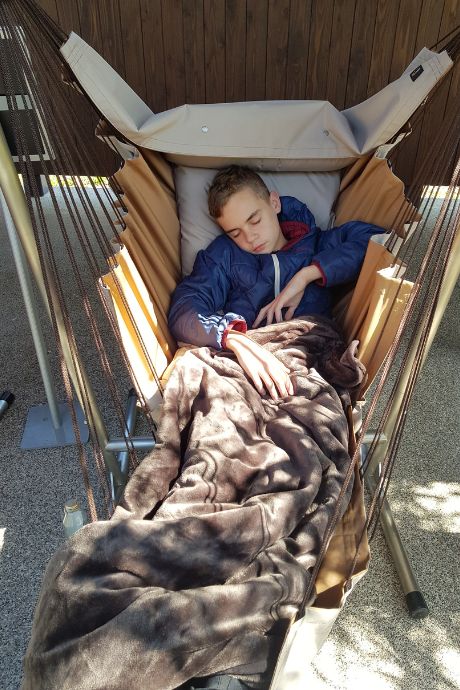
Depending on the location, some guests like to explore the town. For example, places like Kinosaki Onsen and Shibu Onsen are full of guests who walk between onsen properties in their ryokan-provided yukata.
Some ryokan also offer performances or workshops.
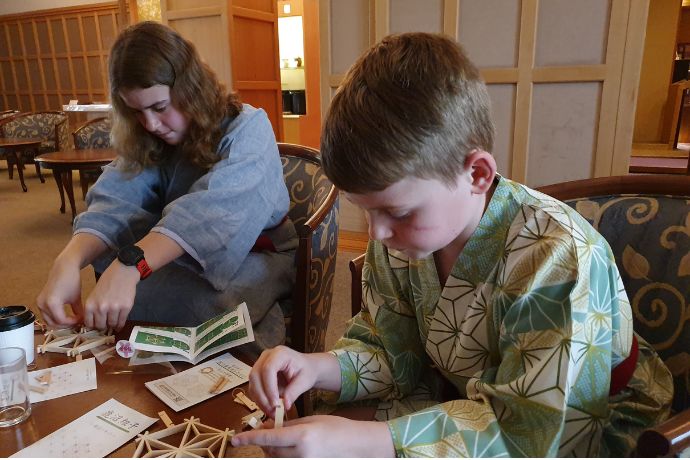
Larger ryokan may have facilities such as karaoke, bars and game rooms. There may also be libraries or large sitting areas.
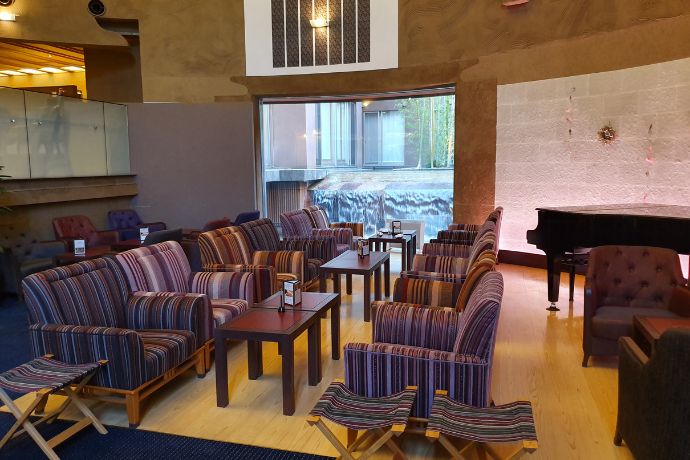

But the main idea is to do nothing – bring a book, arrive hungry and be ready to chill and be pampered in an authentic Japanese setting.
Frequently Asked Questions about Japanese Ryokan
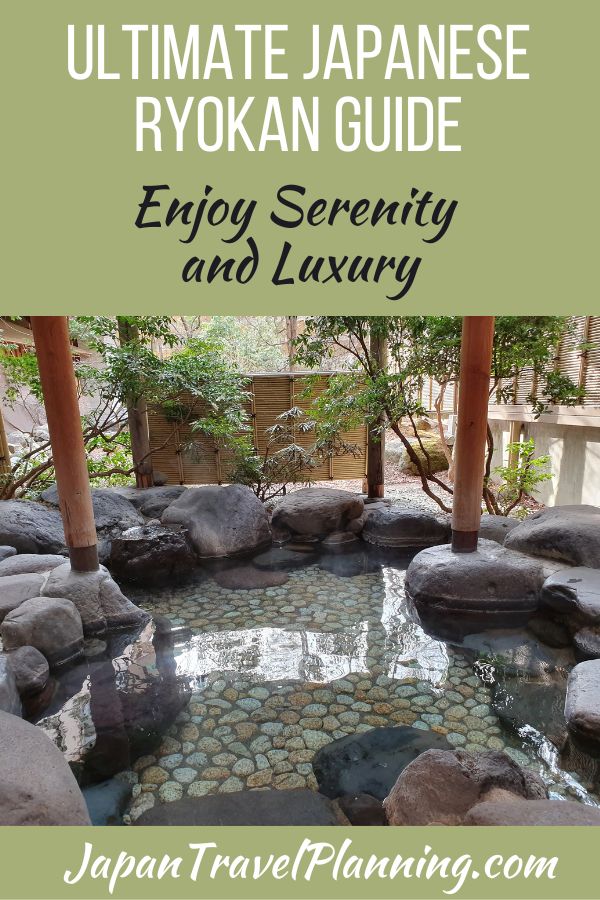
Join the Japan Travel Planning Facebook Group or Discord Server
You are also welcome to join our Japan Travel Planning Facebook Group and our Japan Travel Planning Discord Server – they are great resources to enable you to ask questions about your upcoming trip to Japan!
Disclaimer: This article contains affiliate links. If you book after clicking on one of these links then we may receive a small commission at no extra cost to you.

